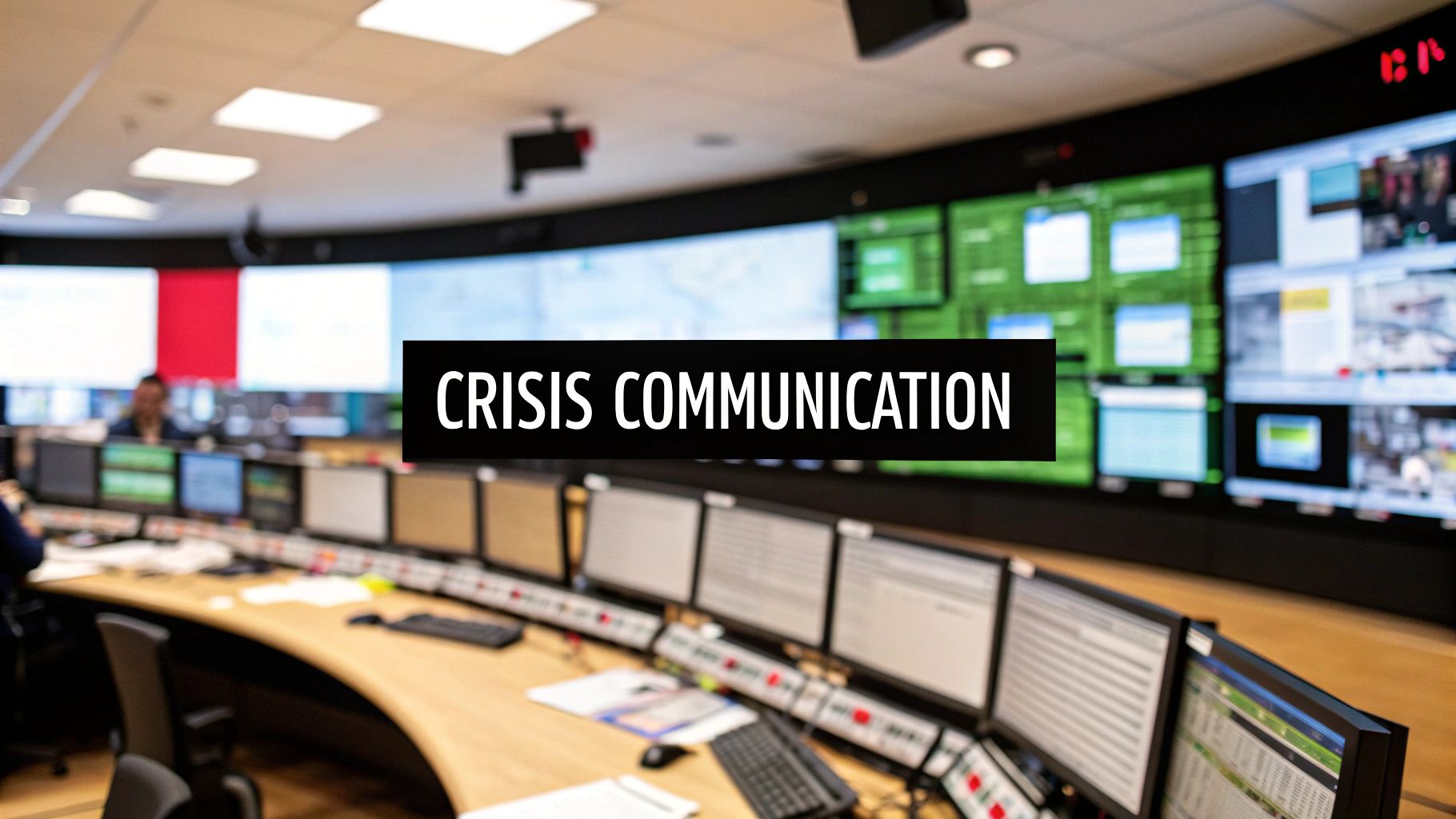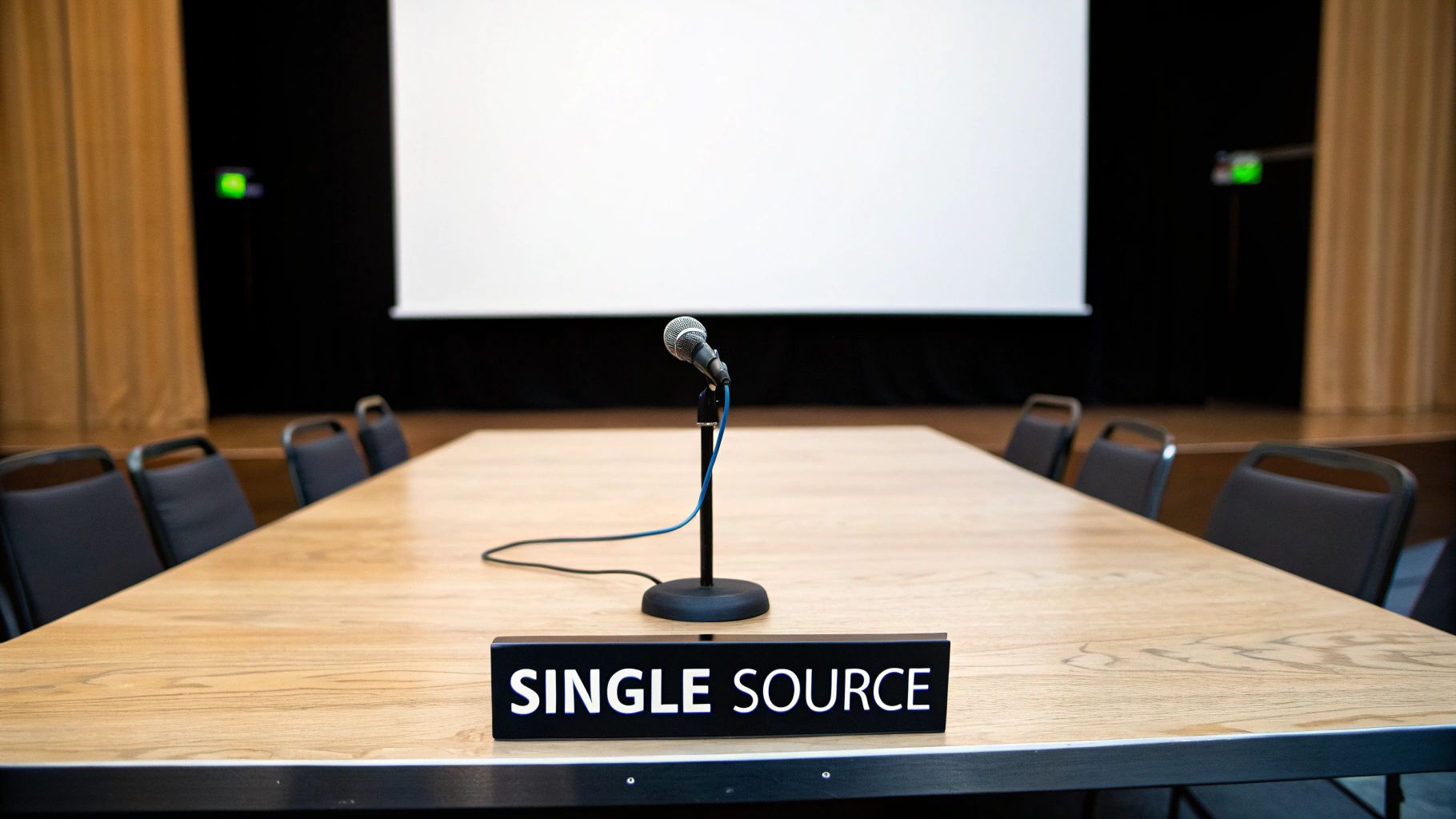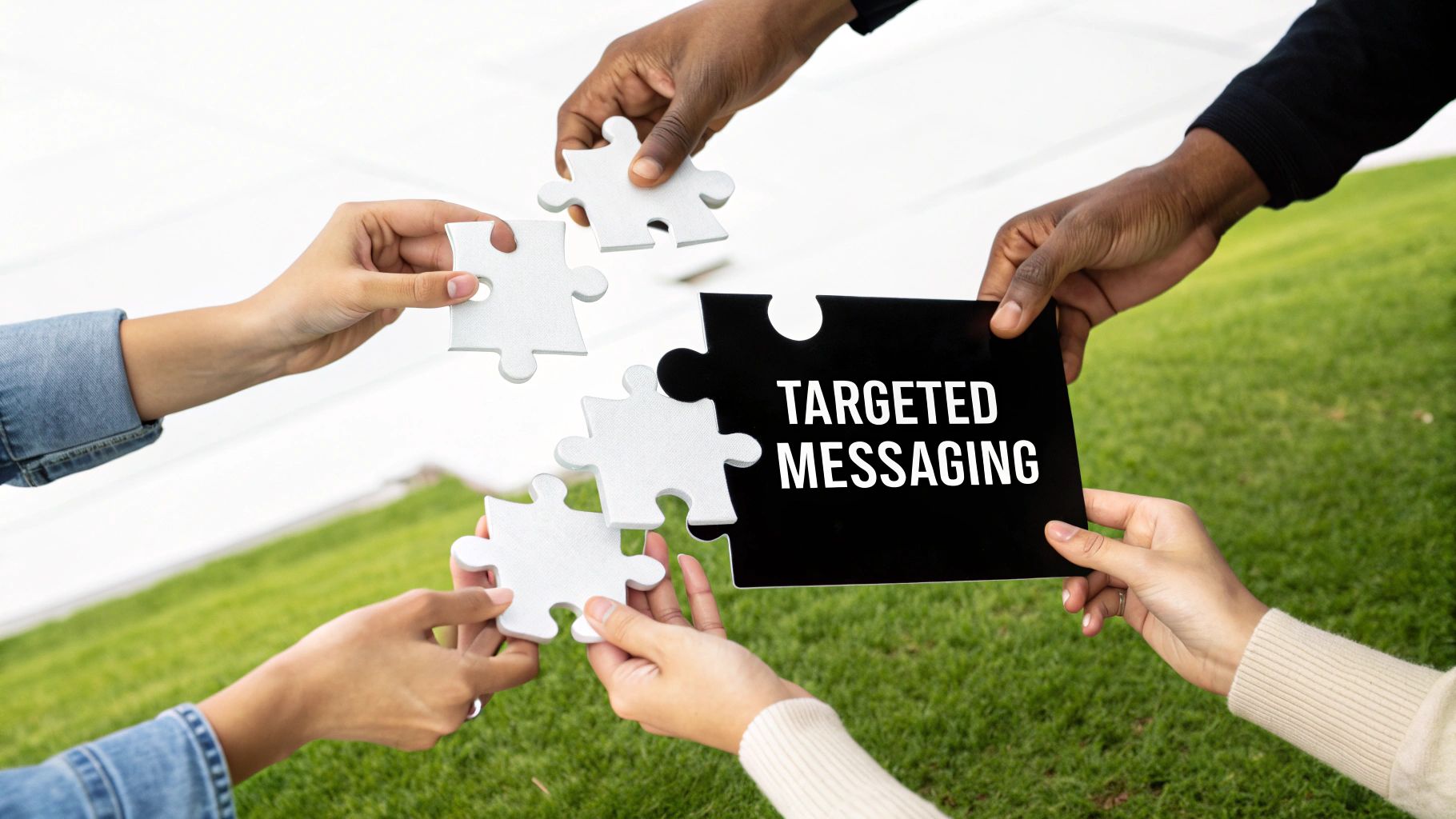
8 Crisis Communication Best Practices for 2025
Published on 2025-09-20
In a 24/7 news cycle, a crisis can ignite in minutes, threatening years of hard-earned brand trust. The difference between a temporary setback and a lasting disaster often comes down to one thing: effective communication. But what does that look like when the pressure is on? It is not about spinning a narrative; it is about protecting and rebuilding trust when it matters most.
This guide moves beyond generic advice to provide a clear, actionable roundup of essential crisis communication best practices. We will break down eight proven strategies designed to help you prepare for, manage, and recover from any challenge with confidence and integrity. From ensuring speed and transparency in your initial response to leveraging a "dark site," these tactics are crucial for any leader.
Understanding the foundational elements is the first step. For a deeper dive, it is helpful to explore what crisis communication entails and how to be prepared for any scenario. This article builds on those core concepts, offering specific, practical steps you can implement immediately to create a resilient communication framework. Let’s get straight to the strategies that will form your modern crisis playbook.
1. Speed and Transparency in Initial Response
The first few hours of a crisis are the most critical. Your initial response sets the tone for the entire situation and can significantly impact public perception and trust. One of the most vital crisis communication best practices is to act with both speed and transparency. This means acknowledging the issue immediately, even if you don't have all the answers, and committing to sharing information openly as it becomes available. Resisting the urge to downplay the problem or hide unflattering details is paramount.

This approach works by seizing control of the narrative before misinformation can spread. A swift, honest statement demonstrates that your organization is taking the situation seriously and is committed to a resolution. This builds credibility and can turn a potential disaster into a case study of responsible leadership.
Real-World Examples
- Johnson & Johnson (1982): When Tylenol capsules were laced with cyanide, CEO James Burke ordered an immediate nationwide recall of 31 million bottles and issued public warnings. This decisive, transparent action, though costly upfront, ultimately saved the brand and became a textbook example of ethical crisis management.
- Buffer (2013): The social media management platform suffered a security breach. Instead of waiting, they immediately informed users via email and social media, providing near-real-time updates on their progress in resolving the hack. Their radical transparency was praised and strengthened customer loyalty.
How to Implement This Practice
To ensure you can respond quickly and honestly, preparation is key.
- Develop Template Statements: Create pre-approved "holding statements" for various potential scenarios (e.g., data breach, product recall, executive misconduct). These templates allow you to respond in minutes, not hours.
- Establish a Clear Approval Chain: Define who needs to approve a crisis statement. Keep this group small and accessible 24/7 to avoid bottlenecks.
- Designate a Spokesperson: Choose and train a spokesperson who can communicate with empathy, authority, and clarity under pressure.
- Continuous Monitoring: Use social listening and media monitoring tools to catch potential crises before they escalate. Early detection enables a faster response.
2. Single Point of Truth Communication
During a crisis, confusion is your enemy. Contradictory messages from different members of your organization can erode public trust, fuel speculation, and make the situation far worse. To combat this, one of the most critical crisis communication best practices is establishing a "single point of truth" by designating one official spokesperson or a primary communication channel to deliver all updates. This ensures every message is consistent, accurate, and controlled.

This centralized approach works by eliminating mixed signals and positioning your organization as a reliable source of information. When stakeholders, from customers to the media, know exactly who to listen to, it streamlines communication and helps you maintain control of the narrative. This consistency is the bedrock of credibility when everything else seems uncertain.
Real-World Examples
- Dr. Anthony Fauci (COVID-19 Pandemic): During the initial outbreak, Dr. Fauci became the primary scientific voice for the U.S. government's health response. His consistent, data-driven communication provided a single, authoritative source for millions seeking clarity amidst widespread uncertainty.
- Mary Barra (GM Ignition Switch Recall): As CEO of General Motors, Mary Barra became the sole public face of the company during the massive ignition switch recall crisis. Her direct, empathetic, and consistent testimony before Congress and in public statements helped rebuild trust and navigate the company through a potential disaster.
How to Implement This Practice
A single point of truth doesn't happen by accident; it requires deliberate preparation and internal discipline.
- Designate and Train Spokespersons: Officially name a primary spokesperson and at least two backups. They should be senior leaders with deep knowledge and receive professional media training to handle high-pressure questions with confidence and empathy.
- Establish a Centralized Information Hub: Create a specific place, such as a dedicated section of your website or a verified social media account, where all official updates will be posted. Direct all inquiries there.
- Align Internally First: Ensure all employees receive information before or at the same time it is released publicly. Achieving this relies on strong internal communication best practices to prevent leaks and ensure everyone is on the same page.
- Develop Clear Escalation Procedures: Define a clear protocol for how information flows to the spokesperson and who has the final authority to approve statements. This prevents delays and internal conflicts during the crisis.
3. Stakeholder-Specific Messaging Strategy
A one-size-fits-all message rarely works during a crisis, as different groups have vastly different concerns and information needs. One of the most effective crisis communication best practices is to develop a stakeholder-specific messaging strategy. This involves tailoring your communication to key audiences like employees, customers, investors, and regulators, ensuring the information they receive is relevant, empathetic, and directly addresses their unique priorities.

This segmented approach works by acknowledging that what matters to an investor (financial impact) is different from what matters to a customer (safety or service disruption) or an employee (job security). By speaking directly to each group's concerns, you build trust, prevent misinformation from filling the void, and demonstrate a comprehensive grasp of the situation's impact. This targeted communication is crucial for maintaining relationships and managing perceptions across all fronts.
Real-World Examples
- Wells Fargo (2016): Following the fake accounts scandal, the bank created distinct communications for different audiences. Customers received apologies and information about account reviews, employees received internal memos about policy changes and ethics training, while investors were given updates on financial repercussions and leadership changes.
- Facebook (2018): During the Cambridge Analytica crisis, Facebook's messaging was highly segmented. Mark Zuckerberg issued public apologies aimed at users, the company sent detailed technical briefs to developers and advertisers about platform changes, and executives prepared formal testimony specifically for government regulators.
How to Implement This Practice
A proactive approach is essential for effective stakeholder messaging.
- Create Stakeholder Maps: Before a crisis hits, identify and map your key stakeholders. Document their primary concerns, preferred communication channels, and relationship with your organization.
- Develop Audience-Specific Templates: Draft core message templates for each key group. While the central facts remain consistent, the tone, context, and call-to-action should be tailored.
- Use Appropriate Channels: Communicate with each group where they are most likely to receive the information. Use internal memos for employees, press releases for media, investor calls for shareholders, and social media or email for customers.
- Sequence Communications Thoughtfully: Consider the order in which you communicate. Typically, it is best practice to inform internal stakeholders (employees) just before or simultaneously with the public announcement.
4. Proactive Social Media Monitoring and Response
In today's digital age, a crisis can ignite and spread on social media within minutes. One of the most essential crisis communication best practices is to treat these platforms as both an early warning system and a primary communication channel. Proactive social media monitoring involves continuously tracking conversations about your brand to catch potential issues before they escalate, while a swift response plan allows you to address concerns, correct misinformation, and engage directly with your audience in real-time.

This approach enables you to join the conversation on your own terms rather than letting it happen without you. By engaging quickly and authentically, you demonstrate that you are listening and care about customer feedback. This not only helps contain the immediate crisis but also builds long-term community trust and brand resilience.
Real-World Examples
- KFC (2018): When a logistics failure forced KFC to close hundreds of UK restaurants due to a chicken shortage, the brand used social media masterfully. They responded with humor and transparency, most famously with a full-page ad rearranging their logo to spell "FCK." Their active and honest social media presence turned a potential disaster into a PR victory.
- Domino's Pizza (2009): After a viral video showed employees tampering with food, Domino's initially delayed its response. However, they later launched a comprehensive social media campaign to address the issue head-on, including a direct apology from the CEO on YouTube. This showed the power of using social channels to rebuild trust directly with customers.
How to Implement This Practice
A strong social media response is built on preparation, not just reaction.
- Use Social Listening Tools: Implement tools like Brandwatch, Sprout Social, or Hootsuite to track mentions, keywords, and sentiment related to your brand. Set up alerts for sudden spikes in negative mentions.
- Establish Escalation Procedures: Create a clear flowchart for your social media team. Define which types of comments can be handled directly and which need to be escalated to legal, PR, or leadership.
- Prepare Response Templates: Develop pre-approved but customizable responses for common issues. This ensures brand consistency and speed while allowing for personalization.
- Train Your Team: Ensure your social media managers are trained in your brand's crisis communication tone, which should be empathetic, transparent, and authoritative. A solid foundation in social media content planning can greatly help in maintaining a consistent voice.
5. Empathy-First Communication Approach
In a crisis, facts and figures often take a backseat to feelings and fears. An empathy-first approach recognizes this human element, prioritizing genuine concern and emotional intelligence in all communications. This practice involves acknowledging the human impact of the crisis, showing authentic care for those affected, and connecting with stakeholder emotions before diving into corporate responses or technical solutions. It's about speaking human-to-human, not corporation-to-consumer.
This method works by building an emotional bridge with your audience, which is essential for rebuilding trust. When people feel heard and understood, they are more likely to listen to your proposed solutions and give you the benefit of the doubt. This is a core tenet of effective crisis communication best practices, as it defuses anger and demonstrates that your organization's values extend beyond its bottom line.
Real-World Examples
- Jacinda Ardern (2019): Following the Christchurch mosque shootings, New Zealand's Prime Minister immediately centered her response on the victims and the Muslim community. Her compassionate language, wearing of a hijab, and focus on national unity were praised globally as a masterclass in empathetic leadership.
- Southwest Airlines (2018): After a fatal engine failure, CEO Gary Kelly's response was deeply personal and heartfelt. He expressed profound sorrow for the deceased passenger and her family before discussing operational details, showing that the human loss was the company's primary concern.
How to Implement This Practice
Integrating empathy requires a conscious shift from a purely logistical response to a human-centric one.
- Lead with the Human Impact: Always begin your statements by acknowledging those affected. Address their pain, fear, or inconvenience before discussing business consequences or next steps.
- Use Human Language: Avoid corporate jargon, legal-speak, and passive voice. Speak plainly and directly, as you would to a concerned friend or family member. This is a key part of an effective brand voice. You can learn more about building an empathetic brand voice on autoghostwriter.com.
- Train for Emotional Intelligence: Equip your designated spokespersons with training in emotional intelligence and active listening. They must be able to convey genuine compassion under intense pressure.
- Show, Don't Just Tell: Back up empathetic words with meaningful actions. This could mean setting up support funds for victims, providing counseling services, or making tangible changes to prevent recurrence.
6. Dark Website and Pre-Crisis Preparation
The most effective crisis communication doesn’t start when a crisis hits; it begins long before. A core tenet of modern crisis communication best practices is establishing a robust infrastructure ahead of time. This includes creating a "dark website" or a pre-built, non-public webpage that can be activated instantly during an emergency. This proactive preparation ensures you have the tools and protocols ready to go, allowing your team to respond with speed and precision rather than scrambling to build from scratch.
This approach works by dramatically reducing response time. When a crisis occurs, the pre-approved site can go live with a single click, providing a centralized, official source of information. This prevents confusion, combats misinformation, and demonstrates that your organization has a competent, well-rehearsed plan for managing difficult situations.
Real-World Examples
- Airlines' Accident Response: Major airlines maintain dark websites with templates ready for the unthinkable event of a crash. These sites are designed to provide immediate information to the public and media, including official statements, contact numbers for family members, and updates on the investigation, ensuring a compassionate and organized response.
- Financial Institutions' Breach Protocols: Banks and financial firms have pre-drafted communication plans and dark web pages specifically for cybersecurity breaches. When a breach is detected, these systems are activated to inform customers about the incident, outline steps they should take to protect their accounts, and provide ongoing updates on security enhancements.
How to Implement This Practice
Systematic preparation is the key to leveraging this strategy effectively.
- Create Scenario-Specific Plans: Develop detailed response protocols and messaging templates for your most likely crisis scenarios, such as product recalls, data breaches, or natural disasters.
- Build Your Dark Website: Design a simple, easy-to-navigate website shell. Pre-populate it with contact information, key company facts, and placeholders for crisis-specific statements. Ensure it can handle high traffic.
- Update Contact Databases Quarterly: Regularly maintain and verify contact lists for key stakeholders, including employees, media, investors, and emergency services.
- Test Your Systems Regularly: Conduct drills and simulations at least annually to test your dark site activation, communication channels, and team readiness. This helps identify and fix weaknesses before a real crisis occurs.
7. Regular Updates and Follow-Through Communication
A crisis is not a single event but a process. One of the most common mistakes in crisis communication is going silent after the initial statement. To maintain trust and manage stakeholder anxiety, you must provide consistent, scheduled updates throughout the crisis and continue communicating well after the immediate danger has passed. This demonstrates an ongoing commitment to resolution and prevention.
This practice works by managing expectations and preventing the spread of rumors. When stakeholders know when and where to expect the next update, they feel more in control and are less likely to seek information from unreliable sources. Long-term follow-through shows that the lessons from the crisis have been integrated into your operations, rebuilding confidence for the future. This is a core tenet of effective crisis communication best practices.
Real-World Examples
- Target (2013): After its massive data breach, Target didn't just apologize. The company provided regular updates on the investigation, offered free credit monitoring, and communicated extensively about the new security measures it was implementing, including the rollout of chip-and-PIN card technology in its stores.
- Boeing (737 MAX Crisis): Throughout the grounding of the 737 MAX fleet, Boeing provided regular updates to airlines, regulators, and the public about software fixes, testing progress, and pilot training protocols. This sustained communication was crucial for eventually regaining regulatory approval and rebuilding industry trust.
How to Implement This Practice
Consistent follow-through requires a strategic and sustained effort.
- Set Clear Expectations: In your initial communication, tell your audience when and where they can expect the next update (e.g., "We will provide another update on our website at 4 PM EST.").
- Use Multiple Channels: Tailor your updates for different channels and stakeholder groups. A detailed email may be appropriate for customers, while a brief, factual post works for social media.
- Be Honest About Progress: Your updates should include what has been resolved, what challenges remain, and what the next steps are. Transparency about obstacles is as important as highlighting successes. To learn more about crafting clear and effective messages, you can review some business writing tips.
- Plan for Long-Term Follow-Up: Create a communication plan for the weeks and months after the crisis is "over" to report on preventative measures and long-term changes.
8. Multi-Channel Integration and Consistency
In today's fragmented media landscape, stakeholders consume information across dozens of different platforms. A critical crisis communication best practice is to ensure your message is coordinated and consistent across every channel, from a press release and website banner to a tweet and an internal employee email. This multi-channel integration guarantees that your audience receives a unified, clear message regardless of where they first encounter it.
This approach works by building a seamless communication front that reinforces your core message, preventing confusion and minimizing the risk of conflicting information. It shows that your organization is organized, in control, and respects its stakeholders enough to meet them on their preferred platforms with a consistent narrative. This method is essential for managing the flow of information and maintaining brand integrity under pressure.
Real-World Examples
- Starbucks (2018): Following the wrongful arrest of two Black men in a Philadelphia store, Starbucks launched a comprehensive, integrated response. CEO Kevin Johnson's apology was shared via video, on the company website, through press releases, and across social media. This was followed by consistent messaging about store closures for racial-bias training, creating a powerful, unified narrative of accountability.
- CDC (COVID-19 Pandemic): The Centers for Disease Control and Prevention used a multi-channel strategy to disseminate critical health information. They held press conferences for traditional media, posted regular updates and infographics on social media, updated their website with detailed guidance, and sent email alerts, ensuring broad and consistent public outreach.
How to Implement This Practice
A cohesive multi-channel strategy requires careful planning and execution.
- Create a Master Content Plan: Develop a central document that outlines the core message and its specific adaptation for each channel (e.g., formal tone for email, concise for Twitter, empathetic for video).
- Assign Channel Ownership: Designate specific team members to be responsible for individual channels. This ensures each platform is managed effectively while they all work from the same core messaging script.
- Use Centralized Management Tools: Employ social media management platforms like Hootsuite or Sprout Social to schedule and monitor posts, ensuring timing and messaging are perfectly aligned.
- Monitor All Channels for Feedback: Actively listen for questions and sentiment on every platform. Use this feedback to refine your messaging in real-time, maintaining consistency while adapting to public concerns.
8-Point Crisis Communication Best Practices Comparison
| Strategy | Implementation Complexity 🔄 | Resource Requirements ⚡ | Expected Outcomes 📊 | Ideal Use Cases 💡 | Key Advantages ⭐ |
|---|---|---|---|---|---|
| Speed and Transparency in Initial Response | High – requires rapid decision-making | Moderate – needs prepared templates & spokesperson | Builds immediate trust, prevents speculation | Early crisis stages needing quick, honest response | Immediate trust, accountability, reduces damage |
| Single Point of Truth Communication | Moderate – centralized approval needed | Moderate – trained spokesperson and backups | Consistent, accurate messaging | Complex crises requiring message control | Eliminates conflicting info, spokesperson credibility |
| Stakeholder-Specific Messaging Strategy | High – requires segmentation & coordination | High – tailored messages across groups | Increased relevance and engagement | Crises affecting diverse stakeholder groups | Targeted communication enhances impact |
| Proactive Social Media Monitoring and Response | High – 24/7 tools and staffing needed | High – monitoring tools and social teams | Early crisis detection, rapid misinformation correction | Real-time, public-facing crises | Early warnings, direct engagement |
| Empathy-First Communication Approach | Moderate – requires emotional intelligence training | Moderate – trained communicators | Builds emotional connection and trust | Crises with high emotional impact | Authenticity, reduces hostility |
| Dark Website and Pre-Crisis Preparation | High – significant upfront setup | Moderate to High – infrastructure and training | Enables immediate, coordinated response | Organizations preparing for potential crises | Rapid activation, clear protocols |
| Regular Updates and Follow-Through Communication | Moderate – ongoing scheduling and management | Moderate – resources for long-term communication | Maintains trust, prevents speculation long-term | Prolonged crisis recovery and resolution phases | Sustains engagement, shows commitment |
| Multi-Channel Integration and Consistency | High – complex coordination required | High – managing multiple platforms and teams | Maximizes reach, reinforces messages | Crises requiring broad stakeholder communication | Unified experience, maximized visibility |
Turning Crisis into an Opportunity for Trust
Navigating a crisis is the ultimate test of an organization's character, leadership, and operational integrity. While the instinct may be to simply minimize damage, the true goal of effective crisis communication is far more ambitious. It's about transforming a moment of vulnerability into a powerful demonstration of your core values, reinforcing stakeholder trust when it matters most. Your response doesn't just solve a problem; it defines your brand for years to come.
The journey from chaos to control is built on the foundational principles we've explored. These are not just theoretical concepts but a practical, actionable roadmap. Mastering these crisis communication best practices means committing to a new standard of organizational readiness and resilience.
From Principles to Practice: Your Key Takeaways
Recapping the core strategies, your crisis response framework should be built around several non-negotiable pillars. Rapid, transparent initial statements set the tone, immediately wrestling control of the narrative. Establishing a single point of truth prevents the spread of misinformation, while tailoring messages to specific stakeholders like employees, customers, and investors ensures everyone feels seen and valued.
Furthermore, an empathy-first approach is crucial; it humanizes your brand and acknowledges the real-world impact of the crisis. This must be supported by proactive social media monitoring, consistent multi-channel updates, and the diligent follow-through that proves your promises are more than just words. The most prepared organizations even have a "dark site" ready to launch, a testament to the power of proactive planning over reactive scrambling.
Key Insight: A crisis doesn't create your company's character; it reveals it. Every action, message, and update is an opportunity to prove your commitment to integrity and build lasting trust.
Actionable Next Steps: Building Your Resilience
Reading about these practices is the first step, but implementation is what separates the resilient from the reactive. Here’s how to move forward:
- Conduct a Crisis Audit: Where are you most vulnerable? Review your current plans against the best practices outlined here, identifying gaps in your preparation, from social media monitoring tools to pre-approved messaging templates.
- Assemble and Train Your Team: Your crisis communication team should be designated before a crisis hits. Run drills and simulations to test your protocols, ensuring everyone knows their role and can execute flawlessly under pressure.
- Develop Your "Playbook": Begin drafting your pre-crisis materials now. This includes holding statements, stakeholder contact lists, and the architecture for a dark website. Having these assets ready allows you to focus on the specifics of the situation when time is critical.
Ultimately, mastering crisis communication is an investment in your brand's longevity. It's about building a foundation so strong that even the most significant challenges become opportunities to strengthen relationships and reinforce what your organization stands for. In today's hyper-connected world, your response is your reputation.
Maintaining a clear, consistent, and empathetic voice is critical during a crisis, especially for leaders and brands active on professional platforms like LinkedIn. Let autoghostwriter help you craft authentic, on-brand messages that build trust, even under pressure. Ensure your professional communication remains a source of strength by visiting autoghostwriter to learn more.